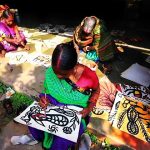
पुराने जमाने में , पिचकारियों को बांस या जानवरों के सींग जैसी प्राकृतिक सामग्रियों से बनाया जाता था, और पानी का छिड़काव करने के लिए एक बल्ब को दबाकर पानी का छिड़काव किया जाता था। पानी में फूलों के रंग या हल्दी जैसी चीजों को मिलाकर उसे रंगीन बनाया जाता था । समय के साथ, पिचकारियां विकसित हुईं और विभिन्न सामग्रियों जैसे धातु, प्लास्टिक, या लकड़ी से तैयार की जाने लगी।




